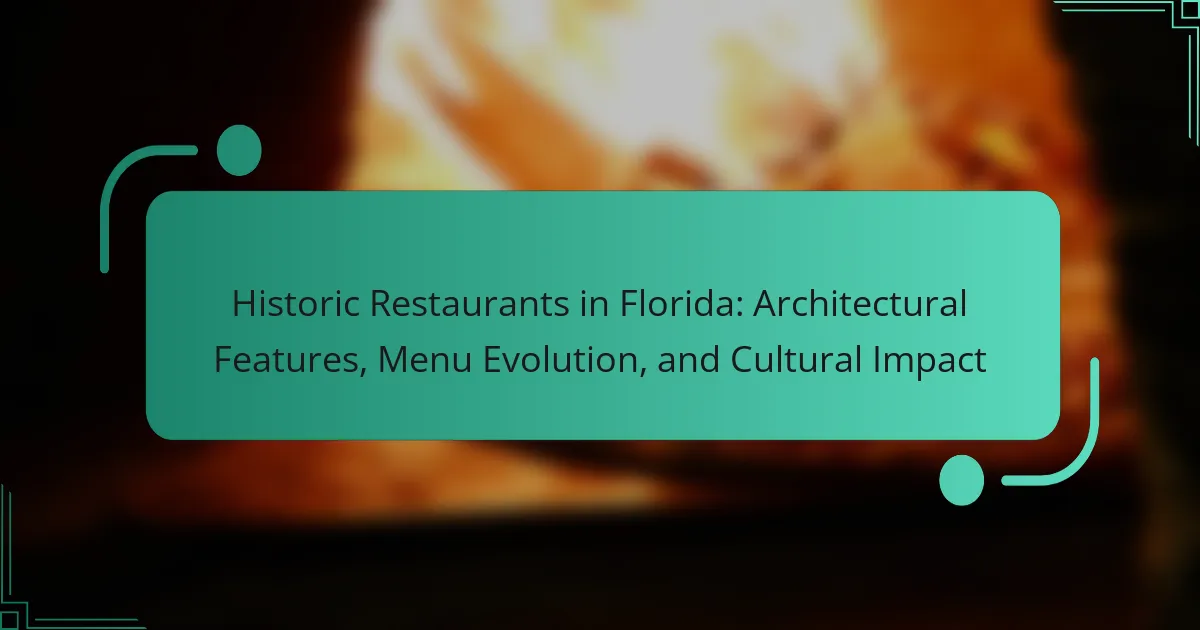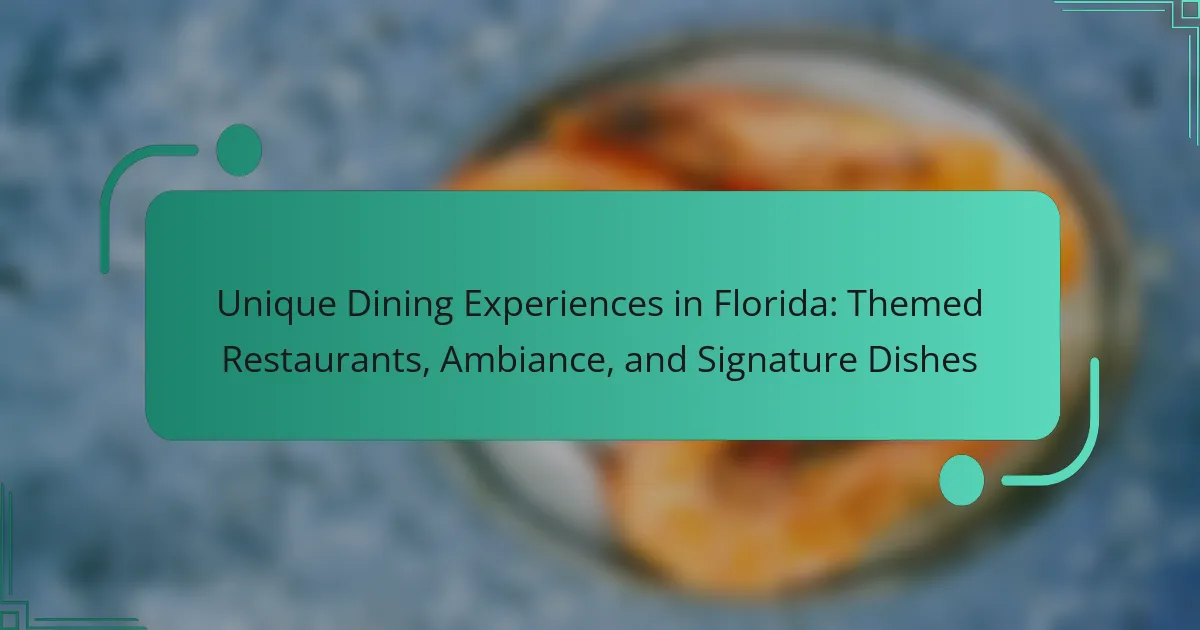Historic restaurants in Florida are significant dining establishments that embody the state’s rich cultural heritage and architectural diversity. These venues, such as the Columbia Restaurant in Tampa and the Olde Pink House in Savannah, showcase unique architectural styles, including Mediterranean Revival, Art Deco, and Colonial designs. Over the years, their menus have evolved to incorporate local ingredients and adapt to contemporary culinary trends while maintaining traditional recipes. Historic restaurants serve as cultural hubs that foster community and attract tourists, providing an authentic experience of Florida’s diverse culinary landscape. Their impact extends beyond food, reflecting the history and social fabric of the region.
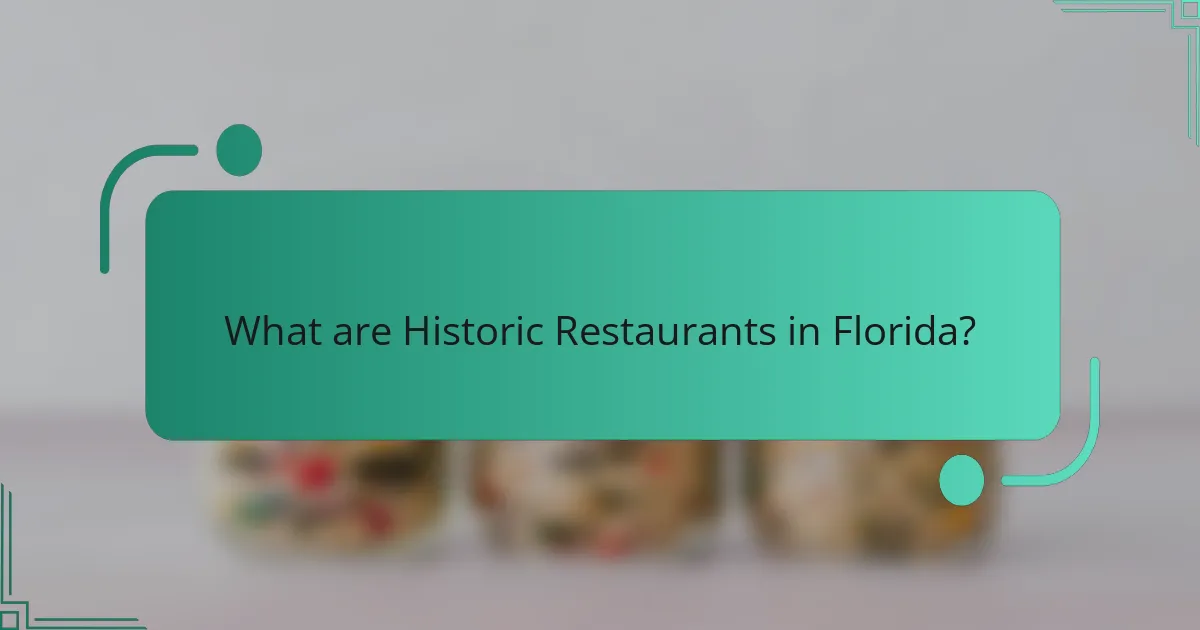
What are Historic Restaurants in Florida?
Historic restaurants in Florida are dining establishments with significant historical value. They often feature unique architectural styles and have been in operation for many years. Examples include the Columbia Restaurant in Tampa, established in 1905, known for its Spanish-Cuban cuisine. Another example is the Olde Pink House in Savannah, which dates back to the 18th century and offers Southern cuisine. These restaurants reflect Florida’s diverse cultural heritage and contribute to its culinary landscape. Their menus often evolve to incorporate local ingredients and traditions while maintaining ties to their historical roots.
How do Historic Restaurants reflect Florida’s cultural heritage?
Historic restaurants in Florida reflect the state’s cultural heritage through their architecture, cuisine, and historical significance. Many of these establishments showcase architectural styles influenced by Spanish, Caribbean, and Native American cultures, representing the diverse history of the region. For example, the iconic Columbia Restaurant in Ybor City features Spanish and Moorish architectural elements, highlighting the influence of early settlers. The menus at these restaurants often incorporate local ingredients and traditional recipes, showcasing Florida’s agricultural bounty and culinary traditions. Dishes like stone crab and key lime pie are deeply rooted in the state’s coastal and agricultural heritage. Additionally, historic restaurants serve as gathering places for communities, preserving stories and traditions passed down through generations. Their longevity and continued operation reflect the cultural importance of food and hospitality in Florida’s history.
What architectural styles are prevalent in Florida’s historic restaurants?
The prevalent architectural styles in Florida’s historic restaurants include Mediterranean Revival, Art Deco, and Colonial Revival. Mediterranean Revival features stucco exteriors and tile roofs, reflecting the influence of Spanish architecture. Art Deco is characterized by bold geometric shapes and vibrant colors, often seen in coastal restaurants. Colonial Revival incorporates elements from early American architecture, such as symmetrical facades and traditional porches. These styles represent Florida’s diverse cultural history and adaptation to its coastal environment. Historic examples include the Columbia Restaurant in Ybor City, showcasing Mediterranean Revival, and the Breakers Hotel’s restaurants, which embody the grandeur of Colonial Revival.
How have these restaurants contributed to local history?
Historic restaurants in Florida have significantly contributed to local history by preserving cultural traditions and architectural styles. Many of these establishments reflect the unique heritage of their regions. For example, the architecture often showcases historical design elements that tell the story of the area’s development. Additionally, their menus frequently feature local ingredients and traditional recipes that have been passed down through generations. This culinary continuity helps maintain the cultural identity of the community. Historic restaurants also serve as gathering places, fostering social connections and community pride. Their longevity often symbolizes resilience and adaptation to changing times. Furthermore, many have been recognized in local heritage programs, further solidifying their role in the historical narrative of Florida.
What role do Historic Restaurants play in Florida’s tourism industry?
Historic restaurants are significant attractions in Florida’s tourism industry. They offer visitors a glimpse into the state’s rich culinary and architectural heritage. Many historic restaurants are located in iconic buildings, enhancing the dining experience with unique atmospheres. Tourists often seek these establishments for authentic local cuisine and cultural experiences. According to a study by Visit Florida, dining is a top activity for tourists, with historic restaurants drawing substantial interest. These venues contribute to the local economy by attracting visitors and supporting jobs in the hospitality sector. Overall, historic restaurants play a vital role in promoting Florida’s cultural identity and enhancing its tourism appeal.
How do tourists perceive the value of dining in historic settings?
Tourists perceive dining in historic settings as a unique and enriching experience. They value the ambiance and authenticity that such locations offer. Historic restaurants often provide a sense of connection to the past. This connection enhances the overall dining experience. Many tourists appreciate the architectural features that reflect the history of the area. They often seek out these dining options for cultural immersion. Research indicates that dining in historic settings can increase satisfaction levels among patrons. A study by the National Trust for Historic Preservation found that 78% of diners prefer restaurants with historical significance. This preference highlights the perceived value of such experiences for tourists.
What unique experiences do these restaurants offer visitors?
Historic restaurants in Florida offer visitors a blend of unique dining experiences. These establishments often feature distinctive architectural styles that reflect their historical significance. Many have preserved original designs, showcasing elements like vintage decor and period furnishings. Visitors can enjoy menus that highlight local ingredients and traditional recipes. These menus often evolve to include modern interpretations of classic dishes. Additionally, some restaurants provide guided tours that educate patrons about their history and cultural impact. Special events, such as themed dinners or live music nights, enhance the overall experience. These factors combined create a memorable atmosphere for diners.
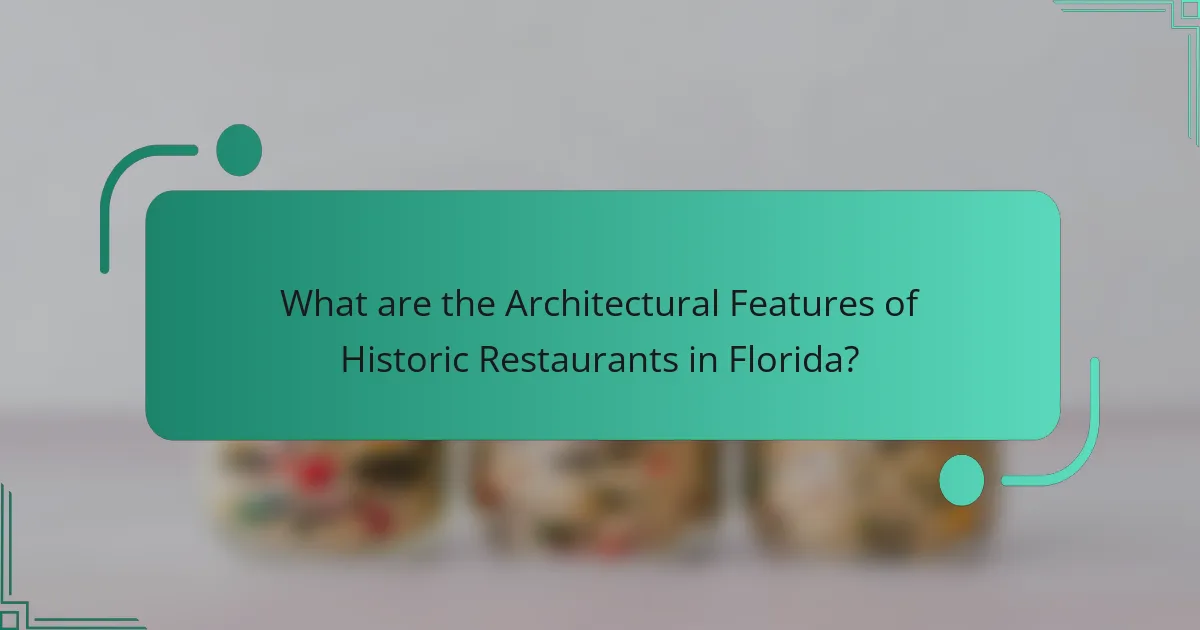
What are the Architectural Features of Historic Restaurants in Florida?
Historic restaurants in Florida often showcase Mediterranean Revival, Art Deco, and Colonial architecture. Mediterranean Revival features stucco exteriors, terracotta roofs, and arched doorways. Art Deco elements include geometric patterns, vibrant colors, and neon signage. Colonial architecture is characterized by symmetrical facades and wooden shutters. Many historic restaurants also incorporate local materials like coquina and tabby. These architectural styles reflect Florida’s diverse cultural influences. For instance, the Columbia Restaurant in Ybor City exhibits Spanish and Moorish design elements. The architectural features not only enhance aesthetic appeal but also tell the story of Florida’s rich history.
How do architectural styles vary among Florida’s historic restaurants?
Architectural styles among Florida’s historic restaurants vary significantly due to diverse cultural influences. Many restaurants showcase Mediterranean Revival architecture, characterized by stucco exteriors and red-tiled roofs. Others feature Art Deco elements, notable for bold colors and geometric shapes, reflecting the 1920s and 1930s design trends. Colonial Revival styles are also present, with symmetrical facades and classical details, echoing early American history.
Additionally, some establishments highlight Mission-style architecture, which includes adobe-like structures and arches, rooted in Spanish colonial heritage. The variation in styles often corresponds to the restaurant’s historical context and location within Florida. For instance, coastal areas may lean towards beachy, casual designs, while urban settings might adopt more formal, historic aesthetics.
These architectural differences illustrate the rich tapestry of Florida’s cultural evolution and its impact on dining experiences.
What are the defining characteristics of Spanish Colonial architecture in restaurants?
Spanish Colonial architecture in restaurants is characterized by stucco exteriors, red tile roofs, and arched doorways. These features reflect the design elements from Spain’s colonial period in the Americas. The use of wrought iron details, such as railings and light fixtures, adds to the aesthetic. Additionally, wooden beams and terracotta tiles are commonly found in the interiors. Courtyards and patios are often integrated into the design, providing outdoor dining spaces. The color palette typically includes warm earth tones, enhancing the inviting atmosphere. This architectural style is rooted in historical influences from the Spanish missions and colonial settlements.
How does Art Deco influence the design of some historic dining establishments?
Art Deco influences the design of some historic dining establishments through its distinctive geometric shapes and bold colors. This architectural style emerged in the 1920s and 1930s, characterized by streamlined forms and ornamental details. Many historic dining establishments incorporate Art Deco elements such as zigzag motifs and stylized floral patterns. The use of materials like chrome, glass, and rich textiles enhances the luxurious ambiance typical of this design. Notable examples include the Streamline Moderne style found in Florida’s historic restaurants. These establishments often feature neon signage, which was popular during the Art Deco period, attracting diners with its vibrant glow. The overall aesthetic creates a sense of elegance and nostalgia, reflecting the cultural trends of the time.
What preservation efforts are in place for these architectural gems?
Preservation efforts for historic restaurants in Florida include local ordinances and state-level initiatives. Many cities have established historical preservation boards to oversee restorations. These boards ensure that renovations maintain the original architectural integrity. Additionally, funding is often available through grants aimed at preserving cultural heritage. The Florida Division of Historical Resources provides resources and support for preservation projects. Tax incentives are also offered to property owners who restore historic buildings. These efforts help to safeguard the unique architectural features of these establishments. Overall, these initiatives play a crucial role in maintaining Florida’s cultural landscape.
How do local regulations protect historic restaurant buildings?
Local regulations protect historic restaurant buildings through preservation ordinances and zoning laws. These regulations often designate specific buildings as historic landmarks. This designation restricts alterations that could compromise their architectural integrity. Additionally, local governments may provide financial incentives for restoration and maintenance. For example, tax credits or grants can support the preservation efforts of these establishments. Furthermore, regulations often require public review for proposed changes to the building. This ensures that any modifications align with the historical significance of the structure. Overall, local regulations play a crucial role in safeguarding the heritage of historic restaurant buildings.
What role do community organizations play in preservation efforts?
Community organizations play a crucial role in preservation efforts. They advocate for the protection of historic sites and educate the public about their significance. Many community organizations collaborate with local governments to secure funding for preservation projects. They often organize events to raise awareness and engage the community in preservation activities. For example, the National Trust for Historic Preservation supports local initiatives and provides resources for preservation. Studies show that communities with active organizations are more successful in preserving their historical heritage. Their involvement promotes local identity and fosters a sense of pride among residents.
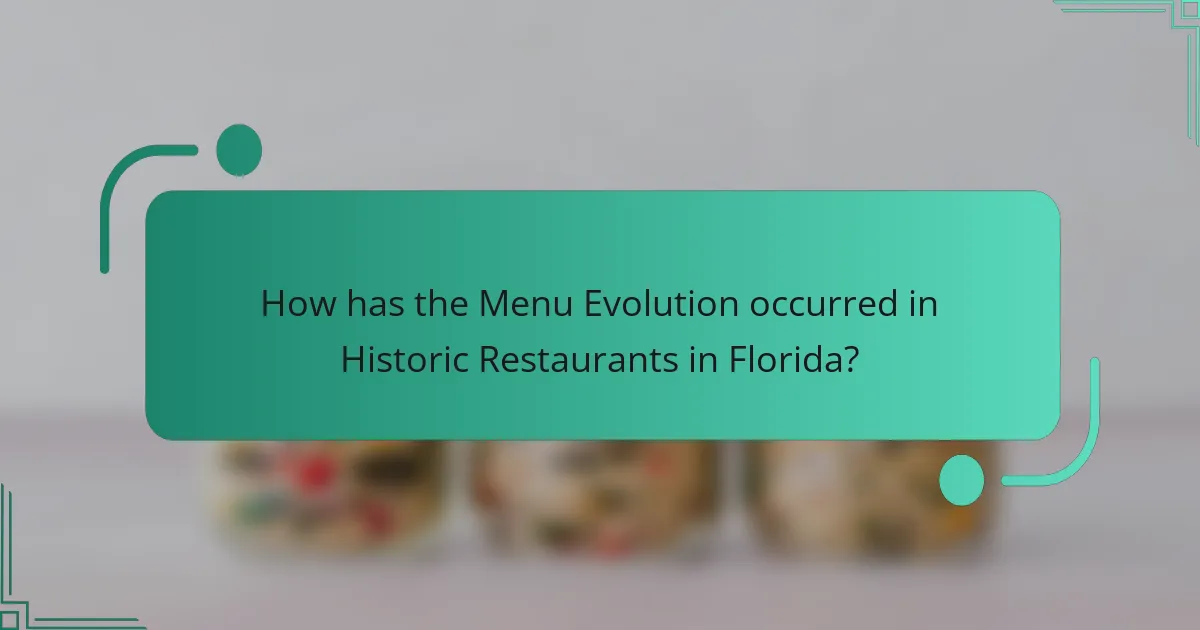
How has the Menu Evolution occurred in Historic Restaurants in Florida?
Menu evolution in historic restaurants in Florida has been influenced by changing culinary trends and local ingredients. Many historic establishments originally featured traditional Southern cuisine. Over time, these menus incorporated diverse influences reflecting Florida’s multicultural population.
For instance, seafood dishes gained prominence due to Florida’s coastal geography. Additionally, the farm-to-table movement has encouraged restaurants to source ingredients locally. This shift supports sustainability and showcases regional flavors.
Historic restaurants have also adapted to dietary trends, offering vegetarian and gluten-free options. Some have embraced fusion cuisine, blending different culinary traditions. The evolution reflects both the state’s heritage and contemporary dining preferences.
Specific examples include the Columbia Restaurant, which has evolved its menu since 1905 to include Spanish and Cuban dishes. Another example is the Old Spanish Sugar Mill, which highlights local produce and traditional recipes. These changes demonstrate a dynamic response to both historical context and modern tastes.
What factors have influenced menu changes over time?
Menu changes over time have been influenced by cultural shifts, economic factors, and dietary trends. Cultural shifts include the incorporation of diverse cuisines reflecting immigration patterns. Economic factors such as food prices and availability impact ingredient choices. Dietary trends, including health consciousness and sustainability, shape menu offerings. Historical events, like the Great Depression, prompted restaurants to adapt to consumer needs. Technological advancements in food preservation and preparation also play a role. Additionally, consumer preferences evolve, leading restaurants to innovate and diversify their menus.
How have local ingredients shaped the menus of historic restaurants?
Local ingredients have significantly shaped the menus of historic restaurants by emphasizing regional flavors and culinary traditions. These establishments often incorporate locally sourced produce, seafood, and meats, reflecting the area’s agricultural and fishing heritage. For example, Florida’s historic restaurants frequently feature fresh seafood caught from nearby waters. This practice not only supports local economies but also enhances the authenticity of the dining experience. Additionally, using local ingredients allows chefs to create dishes that resonate with the cultural identity of the region. Historic restaurants like The Columbia and The Brown Derby have adapted their menus over time to highlight the seasonal availability of local ingredients, ensuring that their offerings remain relevant and appealing. This trend towards local sourcing has been documented in studies focusing on the farm-to-table movement, which emphasizes sustainability and community connection in culinary practices.
What trends in dining culture have impacted menu evolution?
Trends in dining culture that have impacted menu evolution include increased focus on health, sustainability, and local sourcing. Health-conscious consumers demand nutritious options, leading restaurants to innovate with lighter dishes and organic ingredients. Sustainability trends push establishments to reduce waste and use eco-friendly practices, influencing menu choices. The farm-to-table movement emphasizes local sourcing, connecting diners with regional agriculture. Globalization has introduced diverse cuisines, prompting menus to feature international flavors and fusion dishes. Technology has also transformed dining, with online ordering and delivery services shaping menu offerings to cater to convenience. These trends collectively reflect changing consumer preferences and societal values.
What are some signature dishes from Florida’s historic restaurants?
Signature dishes from Florida’s historic restaurants include Key Lime Pie, a dessert originating from the Florida Keys. Another notable dish is the Minorcan Clam Chowder, which reflects the state’s unique cultural influences. Stone Crab Claws are also a signature offering, particularly from restaurants in the South Florida region. The Cuban Sandwich is a staple in many historic eateries, showcasing Florida’s rich Cuban heritage. Fried Green Tomatoes are commonly served in historic Southern-style restaurants throughout the state. These dishes highlight Florida’s diverse culinary history and regional ingredients. Many of these signature dishes have been served for decades, contributing to the cultural fabric of Florida’s dining scene.
How do these dishes reflect the region’s culinary heritage?
These dishes reflect the region’s culinary heritage by showcasing local ingredients and traditional cooking methods. They often incorporate seafood, citrus, and spices native to Florida. Historical influences from Native American, Spanish, and Caribbean cuisines are evident in their flavors and preparations. For example, dishes like gumbo and conch fritters highlight the multicultural aspects of Florida’s food scene. Additionally, many recipes have been passed down through generations, preserving cultural stories and practices. This connection to the past reinforces the significance of culinary traditions in Florida’s identity.
What unique cooking methods are used in these restaurants?
It is not possible to provide a specific answer regarding the unique cooking methods used in historic restaurants in Florida without additional context or details about the restaurants in question. Each restaurant may employ different techniques based on their culinary focus and historical influences.
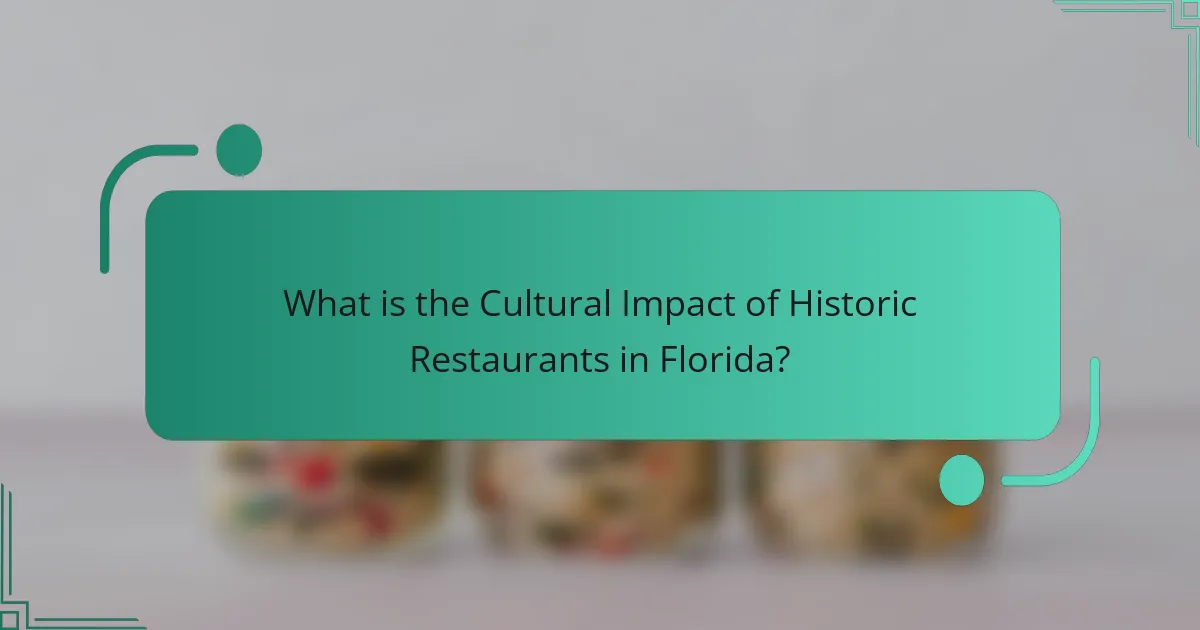
What is the Cultural Impact of Historic Restaurants in Florida?
Historic restaurants in Florida significantly contribute to the state’s cultural identity. They serve as social gathering places that reflect local history and traditions. Many of these establishments have been in operation for decades, preserving culinary practices and recipes unique to Florida.
For example, the Columbia Restaurant, established in 1905, showcases Spanish-Cuban cuisine and has become a landmark in Tampa. The presence of such historic venues fosters a sense of community and belonging among residents.
Additionally, these restaurants often host cultural events, enhancing their role as cultural hubs. They attract tourists, providing an authentic taste of Florida’s diverse heritage. Overall, historic restaurants are vital to understanding Florida’s cultural landscape.
How do historic restaurants contribute to community identity?
Historic restaurants contribute to community identity by preserving local heritage and traditions. They serve as landmarks that reflect the history and culture of the area. These establishments often feature unique architectural styles that represent the time period in which they were built. For example, many historic restaurants in Florida showcase Spanish, Mediterranean, or Art Deco influences.
Additionally, historic restaurants frequently offer traditional dishes that highlight local ingredients and culinary practices. This culinary continuity fosters a sense of belonging among residents. Community events and gatherings often take place in these venues, reinforcing social connections.
Research indicates that such restaurants play a role in attracting tourism, which further enhances community pride. They become focal points for storytelling and cultural exchange, allowing locals and visitors to engage with the area’s history. Overall, historic restaurants are integral to shaping and maintaining community identity.
What events or traditions are hosted by these restaurants?
Historic restaurants in Florida host various events and traditions. These include themed dining nights that celebrate local cuisine. Many restaurants feature live music events, showcasing regional artists. Seasonal festivals often highlight specific culinary traditions. Special holiday menus are created for occasions like Thanksgiving and Christmas. Some restaurants offer cooking classes that focus on traditional recipes. Annual wine tastings are also common, promoting local vineyards. Furthermore, these establishments may participate in community events, fostering local culture. Each event reflects the restaurant’s commitment to preserving Florida’s culinary heritage.
How do they engage with local artists and musicians?
Historic restaurants in Florida engage with local artists and musicians through various initiatives. They often host live music events featuring local talent. This creates a platform for musicians to showcase their work. Additionally, many restaurants display artwork from local artists. This not only decorates the space but also supports the local art community. Some establishments collaborate on special events or themed nights. These events may include art shows or music festivals. Such engagements foster a sense of community and cultural appreciation. They also help attract customers interested in local culture.
What challenges do historic restaurants face in modern times?
Historic restaurants face several challenges in modern times. These include maintaining authenticity while adapting to contemporary tastes. Many historic restaurants struggle with rising operational costs. Increased competition from modern dining establishments also poses a significant challenge.
Adhering to health and safety regulations can be particularly difficult for older buildings. Historic preservation laws may limit renovations, complicating necessary updates. Additionally, attracting younger customers requires innovative marketing strategies.
According to the National Trust for Historic Preservation, many historic restaurants report difficulties in balancing tradition with modern consumer expectations. This tension often affects their long-term viability in a changing market.
How are they adapting to changing consumer preferences?
Historic restaurants in Florida are adapting to changing consumer preferences by updating their menus and enhancing dining experiences. They incorporate local and seasonal ingredients to appeal to health-conscious diners. Many are also offering plant-based options to cater to vegetarian and vegan customers. Additionally, these establishments are embracing technology, such as online reservations and digital menus, to streamline service.
Data from the National Restaurant Association indicates that 60% of consumers prefer restaurants that offer locally sourced ingredients. Furthermore, a survey by Technomic shows that 30% of consumers are more likely to visit a restaurant that offers vegan options. These adaptations reflect a broader trend in the industry towards sustainability and inclusivity in dining choices.
What strategies can help preserve their cultural significance?
Documentation of historical significance is essential for preserving cultural relevance. This includes maintaining records of the restaurant’s history, architecture, and menu evolution. Community engagement fosters appreciation and support for historic restaurants. Events, tours, and educational programs can raise awareness about their cultural impact. Collaboration with local historians and cultural organizations strengthens preservation efforts. Implementing preservation guidelines ensures that architectural features remain intact. Utilizing social media can promote the restaurant’s heritage and attract visitors. Financial support through grants and partnerships aids in maintaining historical integrity. These strategies collectively contribute to the sustained cultural significance of historic restaurants in Florida.
What tips can enhance the experience at Historic Restaurants in Florida?
To enhance the experience at historic restaurants in Florida, consider researching the restaurant’s history before visiting. Understanding the background enriches the dining experience. Engage with the staff about historical details or signature dishes. This interaction can provide unique insights. Try to sample local specialties that reflect the region’s culinary heritage. Many historic restaurants offer dishes that showcase local ingredients. Visit during off-peak hours for a more relaxed atmosphere. This allows for better service and a more enjoyable experience. Lastly, take time to appreciate the architecture and decor, as they often reflect the restaurant’s historical significance.
Historic restaurants in Florida are dining establishments with significant historical and cultural value, often showcasing unique architectural styles and traditional cuisines. This article explores the architectural features prevalent in these restaurants, such as Mediterranean Revival and Art Deco, and examines how their menus have evolved over time to reflect changing culinary trends and local ingredients. Additionally, it highlights the cultural impact of these restaurants on community identity and tourism, as well as the challenges they face in modern times. The discussion includes insights into preservation efforts and strategies to enhance the dining experience at these historic venues.
